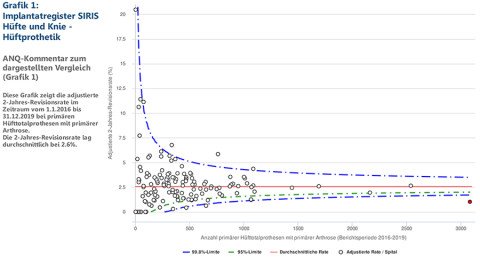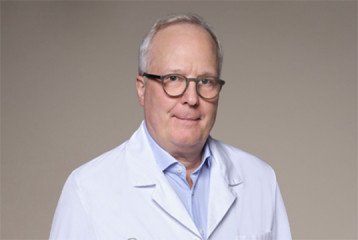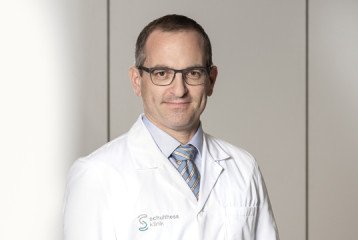Hip Surgery
Annual Report 2022

Our Hip Surgery department is the largest centre of competence for hip joint replacement in Switzerland. In addition to hip prosthetics, our specialists offer the entire spectrum of hip surgery options. The short- and long-term results of the procedures are scientifically documented by our research team, which serves as a quality control measure and foundation for our research work – always with the aim of constantly improving our treatment.
Our hip surgery team has expertise across many areas. Joint replacement, including revision surgery, is just as much a part of our range of treatments as complex joint-preserving procedures such as arthroscopic surgery, position correction and cartilage repair.
The demand for sports injury care is steadily growing. For example, we are treating more and more muscle injuries such as damaged hamstrings (back of the thigh) and adductors (inner thigh).
The number of procedures performed in a hospital (or even by a single surgeon) correlates with the quality of treatment, which is well documented in national or international databases. The large number of cases we treat and our high level of specialisation serve as a strong foundation which enables us to provide patients with optimal care and continuously improve treatment concepts in a scientific way.
High case numbers and a high degree of specialisation
In the spirit of our former clinic director Prof. Norbert Gschwend, our team is highly specialised. As early as the 1960s, he was championing the notion of specialising in the clinic, laying the foundation for the team structure we use today with its division into specialist fields. This means the patient benefits from both the wealth of experience of the individual specialists and overall care across multiple specialisms thanks to the close interdisciplinary cooperation of the departments and teams.
You become better at and more practised in the things you do often. With around 1,200 hip replacements alone performed per year, this practice pays off not only for the experienced surgeons, but also for all the other staff involved in the treatment as well as in terms of helping to improve the procedures themselves. Due to the high number of cases, operating theatre specialists, nursing staff and physiotherapists have acquired a great deal of experience and practice in the treatment of specific conditions. This means it is not only doctors who have expanded their specialisation in treating hip problems, but also other professional groups such as clinical specialists, physiotherapists and operating theatre specialists. And this is beneficial to our patients.
Scientifically sound
What began in the 1970s thanks to Norbert Gschwend with the clinic’s internal documentation centre for hip and knee prostheses has now become a systematic part of daily life at Schulthess. All procedures are monitored and documented by our scientific team with regard to short-term and long-term results in order to continuously improve the quality of treatment. Since 2014, we have implemented a registry for hip replacements to support this process. Our doctors are not only active in clinical practice, but also involved in the scientific side of medicine. In 2022, we published six original papers in peer-reviewed journals in the field of hip surgery alone.
Significantly lower revision rate than the Swiss average
Our vast experience and specialisation have been clearly reflected for years in the official quality figures based on data compiled in the Swiss National Joint Registry SIRIS. Thanks to the registry, data on complication rates relating to individual hospitals and implants can be monitored and compared. The latest publicly available publication reports a two-year revision rate for hip prostheses at Schulthess Klinik of 1.1%. This is two and a half times lower than the Swiss average of 2.6% – and Schulthess Klinik has the highest number of cases in Switzerland. (SIRIS report 2022; report period 01.01.2016 to 31.12.2019). This means that, after a hip implant operation at Schulthess Klinik, significantly fewer patients require revision surgery than the average in hospitals across Switzerland.

Image source: www.anq.ch
Very low infection rate with primary hip replacements
Another important instrument for measuring quality is the Swiss Registry for Postoperative Infections Swissnoso. Since 2009, the majority of Swiss hospitals have opted to use it. To date, the most important quality criterion has been the rate of infection one year after surgery, which stands at 0.74% for the current evaluation period from 1 October 2020 to 30 September 2021 at Schulthess Klinik and is thus below the Swiss average (1.21%). Compared to the previous year (0.94%), the infection rate at Schulthess Klinik has dropped even further.
The data is now recorded 90 days after surgery. For the first evaluation period, from 1 October 2021 to 30 September 2022, the infection rate was 0.21%, which is only about a quarter of the Swiss average (0.81%).
“Bikini incision” for hip surgery
Does the insertion of an artificial hip joint require a large incision? Generally not. In most cases, just a small incision in the skin (<10 cm) is sufficient for this procedure provided it is in the right place. The minimally invasive surgical approach avoids soft tissue damage and the patient can put their full weight on the hip immediately after the operation. In addition, since 2011, instead of the classic longitudinal incision for the anterior approach, we have been using a transverse incision that follows the crease lines of the skin. This is called a bikini incision and leads to improved wound healing and a better cosmetic result.
Our study of 964 patients with results two and four years after surgery shows higher patient satisfaction with bikini incision. After Prof. med. Michael Leunig described this technique for the first time in 2013, this method has become increasingly established internationally. In 2022, we performed a total of 544 of all hip replacements and hip replacement revisions via bikini incision.


